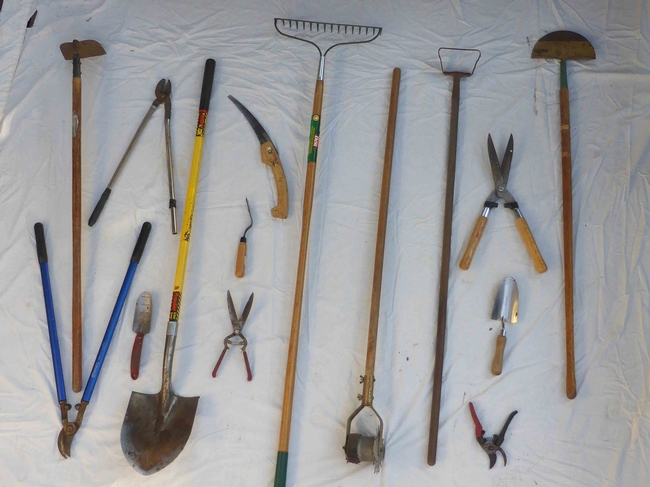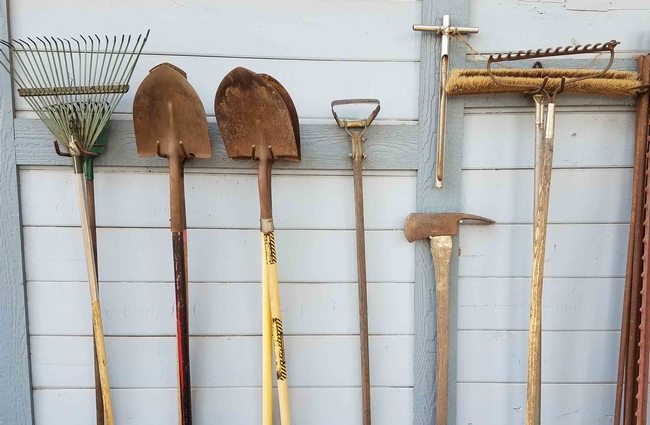Spring is just around the corner, and it's time to make sure your garden tools are in peak condition. Good maintenance not only prolongs the life and usefulness of garden tools; it also improves their performance in the garden. In addition, clean tools help prevent the spread of disease. Maintaining tools is as important as any other job in the garden. It's not difficult, and if done as a two-step process takes only a few minutes.

If the wooden handle of a garden tool is rough, lightly sand it using a sanding sponge or medium grit sandpaper. This will keep it smooth. The handles of tools are often neglected and can be the cause of splinters. Apply a natural, plant-based oil (like linseed oil) a couple of times a year to keep the wood lubricated and prevent cracks. Apply with a clean rag until the handle no longer absorbs the oil. This may take several coats, depending on the dryness of the handle. Handles receive lots of stress over time and can crack if not cared for. If your tool handle is cracked, it's time for a replacement handle. Make sure to thoroughly clean fiberglass and plastic handles and check for any damage. Replace if necessary.
Pruners, loppers, and other hand tools require the same care as long-handled tools after use. Using a foaming household cleaner is helpful because of the moving parts on hand-held tools. Spray, allow to soak in, wipe down with a clean rag or use a wire brush if the tool is covered in a heavy residue. Make sure to wipe down the tool or let it air dry in the sun.

There are a few types of files, including: flat mill files, round or half-round files, whetstones, and pocket files. The type of file used will probably depend on what needs to be sharpened. A hand pruner can be sharpened with a smaller file, while a ten-inch mill file may be more appropriate for a shovel's edge. Sharpen only the inside edge of a shovel. Sharpening both sides of the shovel reduces both effectiveness and stability. The goal is to sharpen the shovel's edge without taking off too much metal. Once sharpened, it is important to oil the blade to prevent rust.
When sharpening hand pruners, you may want to loosen the pivot bolt to separate the blades. If using a small pocket file, this will not be necessary. Make sure the pruners are clean and rust free. A vise is a helpful stabilization tool. When using a vise, make sure the pruners are positioned so the cutting edge receives the proper bevel. A useful tip for following the bevel is to use a marker to color the edge and file until the color is gone. The Master Gardeners of San Diego County have a helpful short video demonstrating the tool sharpening process on their website.
Sanitization is an extremely import practice in the garden. It should be done before pruning and when moving from plant to plant. Sanitization helps prevent the spread of viruses, cankers, and vascular system diseases that affect the health of the garden. Clorox wipes and disinfectant sprays can be used, as well as rubbing alcohol or a home-made 10% bleach solution using one-part bleach to nine parts water. Rubbing alcohol should be 70–100% isopropyl or ethanol alcohol. Chlorine bleach can be corrosive and may cause pitting to your pruner's blades over time. These pits may harbor microbes that damage plants. If using a bleach solution or Clorox wipes, be sure to clean your tools with soap and water before putting them away.
Equipment list for maintaining tools:
- Safety glasses
- Gloves
- Sandpaper, steel wool, wire brush
- Disinfectant
- Plant-based oil
- Bench vise
- Files
- Clean rags, dish soap
With proper maintenance, garden tools should last a lifetime.
UC Master Gardeners of Butte County are part of the University of California Cooperative Extension (UCCE) system. To learn more about us and our upcoming events, and for help with gardening in our area, visit our website. If you have a gardening question or problem, email the Hotline at mgbutte@ucanr.edu (preferred) or call (530) 538-7201.